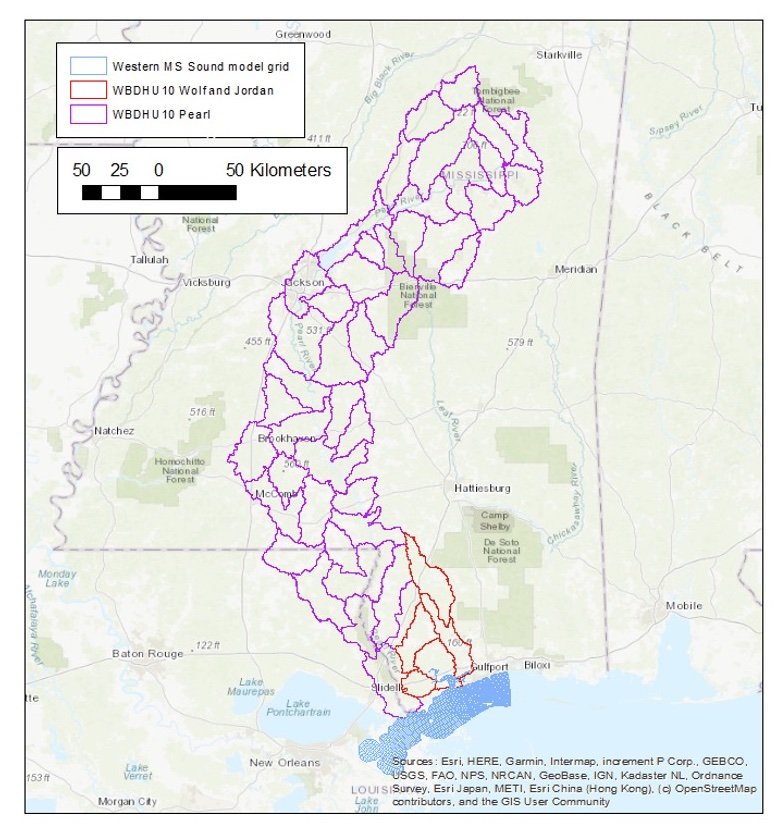Core Research Program 2 - Mississippi State University
Principal Investigators: Adam Skarke, Robert Moorhead, Padmanava Dash, Prem Parajuli
Team Members: Rebecca Gilpin, Tia Offner, Shreeya Bhattarai, Ankita Katkar, Sankar Sasidharan
Undergraduate Intern: John Preston Liles (Deepwater Horizon Memorial Internship)
Award Amount: $388,184
Project Description
Goal:
Integrate watershed, riverine, and estuarine water quality models and monitoring data for the western Mississippi Sound.
Why it is Important:
There is currently a lack of understanding regarding the dynamics of freshwater inflow into the MS Sound. Nutrient loading, bacterial loading, harmful algal blooms, hypoxia, and oyster habitat suitability are all issues that depend on the quantity, quality, and dynamics of freshwater inflow.
An understanding of the baseline conditions, seasonal trends, and atypical conditions of freshwater inflow into the Mississippi Sound is critical for successful management interventions regarding altered salinity regimes, harmful algal blooms, hypoxia and bacteria.
Objectives:
Development of Soil and Water Assessment Tool (SWAT) models for Jourdan and Wolf Rivers.
Calibration and validation of SWAT models with in situ hydrology and water quality data from Jourdan and Wolf Rivers.
Integrate SWAT models with existing hydrodynamic, water quality, and oyster habitat suitability models for the Pearl River and western Mississippi Sound.
Continue the work done in Core 1 via the collection of unmanned aerial system (UAS) data with simultaneously collected in situ samples for determining the distribution of the major biogeochemical parameters in the western Mississippi Sound. A continuation of the work done.
Expected Outcomes and Management Impacts:
The development and integration of models for this project will improve our capacity to observe, understand, and predict the spatial variability of water quality parameters in the western Mississippi Sound.
These water quality parameters affect oyster health and are a fundamental component of oyster habitat suitability models.
Resulting models can be used to evaluate the water quality conditions and variability at existing oyster reefs as well as future reef sites.
Project Outputs
-
Sankar MS, Dash P, Lu Y, Hu X, Mercer AE, Wickramarathna S, Beshah WT, Sanders SL, Arslan Z, Dyer J, Moorhead RJ. 2023. Seasonal changes of trace elements, nutrients, dissolved organic matter, and coastal acidification over the largest oyster reef in the Western Mississippi Sound, USA. Environ. Monit. Assess. 195. Link.
Bhattarai S, Parajuli PB, Filip To SD. 2023. Comparison of flood frequency at different climatic scenarios in coastal forested watersheds. Climate 11(2). Link.
Bhattarai S, Parajuli PB. 2023. Best management practices affect water quality in coastal watersheds. Sustainability 15. Link.
-
Bhattarai S, Parajuli PB “Assessment of BMP practices on water quality of coastal watersheds in Mississippi” ASABE Annual International Meeting (Virtual), July 17-20, 2022
Bhattarai S, Parajuli PB, Filip To “Evaluation of terrestrial flow into coastal water by anticipating the sediment yield and nutrient loss” Mississippi Water Resources Conference, Starkville, MS, April 12-14, 2022
Dash P, Moorhead RJ, Herman J, Sankar MS, Moorhead J, Beshah W, Chesser D, Lowe W, Simmerman J, and Turnage G. “Evaluation of water quality data collected using a novel autonomous surface vessel”, Global Oceans 2021 Conference and Exposition, San Diego, CA, September 20-23, 2021.

